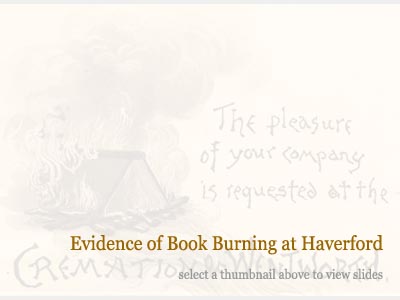Book cremations in the late 19th century at Haverford


 Loading image. Please wait
Loading image. Please wait
From the beginning, the Library was a repository of scholarly books in the sciences, philosophy and the classics. The Library Committee sought to "procure books of standard and durable value," and their aim was to make it an important reference library, "especially for works and manuscripts relating to our own Religious Society." While these venerable aims are still very much a part of the Library's collecting philosophy, individuals and groups from the campus community have long prompted the broadening of collections to include other types of works. Key stakeholders whose actions and interests have shaped our changing collections are featured below.
While reverence for books and collections has never gone out of style at Haverford, an unusual and irreverent tradition developed in the late 19th century. On an annual basis, sophmores voted for their least favorite required book. The winning text was then cremated and given an elaborate (and expensive) funeral. Surviving artifacts from the College Archives attest to the talent, creativity, and humor of the participating students.








